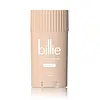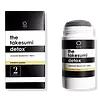What's inside
What's inside
 Key Ingredients
Key Ingredients

 Benefits
Benefits

 Concerns
Concerns

 Ingredients Side-by-side
Ingredients Side-by-side

Propanediol
SolventWater
Skin ConditioningTapioca Starch
Sodium Stearate
CleansingDimethyl Lauramide/Myristamide
EmulsifyingDiatomaceous Earth
AbrasiveGlycerin
HumectantParfum
MaskingSilica
AbrasiveGlyceryl Caprylate
EmollientSaccharomyces Ferment Filtrate
HumectantLactobacillus/Papaya Fruit Ferment Extract
AbrasiveAllantoin
Skin ConditioningEthylhexylglycerin
Skin ConditioningAvena Sativa Kernel Flour
AbrasiveCarica Papaya Seed Oil
HumectantAnanas Sativus Fruit Extract
Skin ConditioningBisabolol
MaskingAloe Barbadensis Leaf Juice
Skin ConditioningBenzyl Alcohol
PerfumingCoumarin
PerfumingHydroxycitronellal
PerfumingLactobacillus Ferment
Skin ConditioningFarnesol
PerfumingBenzyl Salicylate
PerfumingBenzyl Benzoate
AntimicrobialLimonene
PerfumingGlyceryl Undecylenate
EmollientMaltodextrin
AbsorbentPropanediol, Water, Tapioca Starch, Sodium Stearate, Dimethyl Lauramide/Myristamide, Diatomaceous Earth, Glycerin, Parfum, Silica, Glyceryl Caprylate, Saccharomyces Ferment Filtrate, Lactobacillus/Papaya Fruit Ferment Extract, Allantoin, Ethylhexylglycerin, Avena Sativa Kernel Flour, Carica Papaya Seed Oil, Ananas Sativus Fruit Extract, Bisabolol, Aloe Barbadensis Leaf Juice, Benzyl Alcohol, Coumarin, Hydroxycitronellal, Lactobacillus Ferment, Farnesol, Benzyl Salicylate, Benzyl Benzoate, Limonene, Glyceryl Undecylenate, Maltodextrin
Glycerin
HumectantWater
Skin ConditioningMaranta Arundinacea Root Powder
Skin ConditioningPropanediol
SolventSodium Stearate
CleansingHydrated Silica
AbrasiveSaccharomyces Ferment Filtrate
HumectantAloe Barbadensis Leaf Juice
Skin ConditioningMaltodextrin
AbsorbentAllantoin
Skin ConditioningSalicylic Acid
MaskingSorbic Acid
PreservativeCharcoal
AbrasiveMagnesium Hydroxide
AbsorbentBenzyl Alcohol
PerfumingPotassium Sorbate
PreservativeSodium Benzoate
MaskingCitrus Sinensis Peel Oil Expressed
PerfumingCitrus Aurantium Bergamia Fruit Oil
MaskingCitrus Grandis Peel Oil
MaskingGlycerin, Water, Maranta Arundinacea Root Powder, Propanediol, Sodium Stearate, Hydrated Silica, Saccharomyces Ferment Filtrate, Aloe Barbadensis Leaf Juice, Maltodextrin, Allantoin, Salicylic Acid, Sorbic Acid, Charcoal, Magnesium Hydroxide, Benzyl Alcohol, Potassium Sorbate, Sodium Benzoate, Citrus Sinensis Peel Oil Expressed, Citrus Aurantium Bergamia Fruit Oil, Citrus Grandis Peel Oil
Ingredients Explained
These ingredients are found in both products.
Ingredients higher up in an ingredient list are typically present in a larger amount.
Allantoin is a soothing ingredient known for its protective and moisturizingg properties. Because of this, it is often added to products with strong active ingredients.
Studies show higher concentrations of this ingredient can promote wound healing.
Though it can be derived from the comfrey plant, allantoin is produced synthetically for cosmetic products to ensure purity.
Learn more about AllantoinAloe Barbadensis Leaf Juice comes from leaves of the aloe plant. Aloe Barbadensis Leaf Juice is best known for helping to soothe sunburns. It is also anti-inflammatory, moisturizing, antiseptic, and can help heal wounds.
Aloe is packed with good stuff including Vitamins A, C, and E. These vitamins are antioxidants, which help fight free-radicals and the damage they may cause. Free-radicals are molecules that may damage your skin cells, such as pollution.
Aloe Barbadensis Leaf Juice also contains sugars. These sugars come in the form of monosaccharides and polysaccharides, folic acid, and choline. These sugars are able to help bind moisture to skin.
It also contains minerals such as calcium, 12 anthraquinones, fatty acids, amino acids, and Vitamin B12.
Learn more about Aloe Barbadensis Leaf JuiceBenzyl Alcohol is most commonly used as a preservative. It also has a subtle, sweet smell. Small amounts of Benzyl Alcohol is not irritating and safe to use in skincare products. Most Benzyl Alcohol is derived from fruits such as apricots.
Benzyl Alcohol has both antibacterial and antioxidant properties. These properties help lengthen the shelf life of products. Benzyl Alcohol is a solvent and helps dissolve other ingredients. It can also improve the texture and spreadability.
Alcohol comes in many different forms. Different types of alcohol will have different effects on skin. This ingredient is an astringent alcohol.
Using high concentrations of these alcohols are drying on the skin. They may strip away your skin's natural oils and even damage your skin barrier. Astringent alcohols may also irritate skin.
Other types of astringent alcohols include:
According to the National Rosacea Society based in the US, you should be mindful of products with these alcohols in the top half of ingredients.
Any type of sanitizing product will have high amounts of alcohol to help kill bacteria and viruses.
Learn more about Benzyl AlcoholGlycerin is already naturally found in your skin. It helps moisturize and protect your skin.
A study from 2016 found glycerin to be more effective as a humectant than AHAs and hyaluronic acid.
As a humectant, it helps the skin stay hydrated by pulling moisture to your skin. The low molecular weight of glycerin allows it to pull moisture into the deeper layers of your skin.
Hydrated skin improves your skin barrier; Your skin barrier helps protect against irritants and bacteria.
Glycerin has also been found to have antimicrobial and antiviral properties. Due to these properties, glycerin is often used in wound and burn treatments.
In cosmetics, glycerin is usually derived from plants such as soybean or palm. However, it can also be sourced from animals, such as tallow or animal fat.
This ingredient is organic, colorless, odorless, and non-toxic.
Glycerin is the name for this ingredient in American English. British English uses Glycerol/Glycerine.
Learn more about GlycerinMaltodextrin is a polysaccharide. It is derived from starch such as rice, corn, wheat, or potato starch.
In food, Maltodextrin is used to improve the texture and thicken a product. Due to its structure, it can help create a gel texture. As an emulsion stabilizer, it helps keep the ingredients in a product together.
As a polysaccharide, Maltodextrin has moisturizing properties. Polysaccharides are a type of carbohydrate. The top layer of skin uses polysaccharides to retain water, keeping the skin hydrated.
Maltodextrin is water soluble and has a sweet taste.
Learn more about MaltodextrinPropanediol is an all-star ingredient. It softens, hydrates, and smooths the skin.
It’s often used to:
Propanediol is not likely to cause sensitivity and considered safe to use. It is derived from corn or petroleum with a clear color and no scent.
Learn more about PropanediolSaccharomyces Ferment Filtrate is created from fermenting Saccharomyces, a yeast also known as baker's yeast or brewer's yeast.
As a humectant, Saccharomyces Ferment Filtrate helps draw moisture from the air to your skin to keep your skin hydrated. The humectant properties comes from its beta-glucan content.
Sodium stearate is the sodium salt of stearic acid.
The structure of sodium stearate makes it both a cleanser and emulsifier. As a cleanser, it helps dissolve dirt, oil, and other pollutants. As an emulsifier, it helps prevent ingredients from separating. This adds stability to the formula.
Water. It's the most common cosmetic ingredient of all. You'll usually see it at the top of ingredient lists, meaning that it makes up the largest part of the product.
So why is it so popular? Water most often acts as a solvent - this means that it helps dissolve other ingredients into the formulation.
You'll also recognize water as that liquid we all need to stay alive. If you see this, drink a glass of water. Stay hydrated!
Learn more about Water